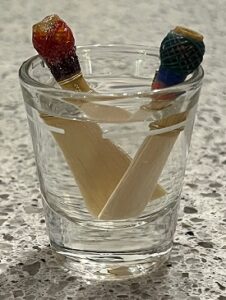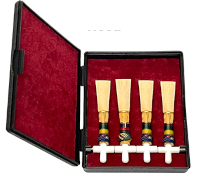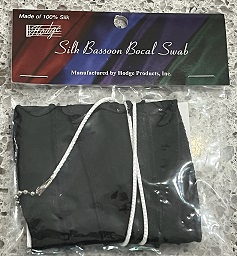Bassoon reeds are expensive. These days one bassoon reed can cost anywhere from $12 to $35 dollars. This means you will want to take very good care of every reed. If you handle, rotate, soak, rinse, and store reeds properly you can easily get 4 to 6 weeks of use out of a reed. Here are some rules for dealing with the bassoon reed:
Handle It Carefully!
ALWAYS know where your reed is. This is especially important when counting rests, waiting for rehearsal to start, or packing up after rehearsal when the reed is not in your mouth.
NEVER let your reed hit against your chair, your music stand, the wall behind you, your teeth, your neighbor’s teeth, etc. It will crack. Keep the reed in visual range when it is on the bocal.
- When assembling the bassoon, add the reed last (after the bassoon is in playing position).
- When disassembling the bassoon, remove the reed first and place it in a safe location.
- The reed will not crack from the force of your tongue (articulation), but it will crack if it hits your teeth or some other hard object.
Rotate It!
ALWAYS have at least three reeds in your reed case. Reeds that are cracked or that don’t work do not count!
NEVER let your “favorite reed” be the only one in your case. Get new reeds when you are down to just one or two.
- If you only have one, it will most likely give out or crack before or during the concert.
- If you only have two you will always play on your favorite one, it will crack, and then you will have to play the concert on a brand-new reed.
ALWAYS follow the Rotation Principle:
- Have at least three or four reeds in your reed case.
- Play a different one each time you practice or rehearse so you know how each reed feels and plays.
Benefits of the Rotation Principle:
You will learn pretty quickly that playing on a brand-new reed is not as easy or comfortable as playing on one that has been broken in from being played for a few days.
- Rotating will allow you to become familiar with how each reed in your case feels and plays. This means never having to play a concert on a brand-new reed because all of the reeds in your case will be broken in.
- Rotating through a set of reeds keeps you from becoming too dependent upon the “feel” of a certain reed.
- Rotating helps you to play correctly rather than adapting to the tendencies of a “favorite” reed.
- Rotating will also extend the life of each reed by allowing it time to dry and rest between uses.
Soak It in Water!

ALWAYS soak the reed adequately before each use.
NEVER leave the reed sitting in water for more than 10 minutes. Over-soaking will cause the reed to swell and warp, and the reed will become waterlogged and hard to play.
- Soak the reed for a minimum of 2-3 minutes in room temperature water. The reed needs to absorb the water, so a quick rinse in a fountain or under a faucet is not enough.
- Soak the entire reed (blade and tube).
- “Mouth soaking” a bassoon reed is not enough to allow optimum vibration and flexibility. No one has that much saliva!
- Room temperature water is best but if cold is all you have access to, increase the soaking time by a couple of minutes. If warm water is all you have, decrease the soaking time.
*Note: warm water will sometimes do wonders for an old reed.
Rinse It in Water!
ALWAYS rinse the reed and gently pat it dry before putting it back in your reed case. This will help the reed last much longer.
- Swish the reed around in the reed water (assuming the reed water is clean).
- Lightly shake or blow through the reed (make certain you aren’t facing anyone).
- Gently brush it along your sleeve or pant leg to remove excess moisture.
Store It in a Reed Case!

ALWAYS store the reed in a case that provides protection AND ventilation. A completely sealed container will grow mold/mildew – ick!
NEVER leave your reed loose in your bassoon case, backpack, purse, etc. That is like throwing away money because the reed will crack. Keep your reeds in a protective reed case.
Your reed case does not have to be fancy or expensive, but it does need to provide protection for the reeds. I repurposed a small metal Sucrets tin for my first reed case. The larger size Altoids© tin will also work. The tins that sometimes come with Celestial Seasonings tea are also a good size. Here’s how to create your own reed case from a tin that is approximately 3.75″ x 2.5″ x .75″
- Empty and wash the tin and let it dry completely.
- Use an ice pick or drill to make 3-4 holes in the lid.
- Line the top and bottom of the tin with Kleenex or cotton balls to provide cushioning for the reeds.
- Check the cushioning material regularly for discoloration (mold/mildew). Replace the material if it begins to discolor.
Online Sources for Bassoon Reed Cases
- Bassoon Reed Cases – Charles Double Reed Company (charlesmusic.com)
- Bassoon Reed Cases from Forrests Music
- Reed Cases Archives | Miller Marketing (millermarketingco.com)
- For Your Reeds – Reed Cases – Hodge Products, Inc. (hodgeproductsinc.com)
TIP: Make sure your reeds dry out from one day to the next. If you open your reed case and the reeds are still damp from the previous day you will need to do something to help them dry out.
- Put your reed case in a safe location and leave it open overnight.
- Leave your reed case open under the light from a desk lamp for a couple of hours every day.
AFTER AN ILLNESS
The best action is to throw away any reeds you played while you were sick and wipe down your reed case with rubbing alcohol and let it dry before adding new reeds. Your health is worth more than the cost of a reed. However, if it was a mild illness and the reed is a good one, you might consider disinfecting the reed using a sanitizing product such as hydrogen peroxide or Sterisol germicide.
- Combine 1 part hydrogen peroxide to 3 parts water.
- Soak the reed in the solution for 15 minutes.
- Rinse the reed thoroughly with water.
- Gently pat dry and leave in under a desk lamp for 1-2 hours until completely dry.
Follow instructions for use on the bottle of Sterisol germicide concentrate.
Sterilizer Liquids | Miller Marketing (millermarketingco.com)
Don’t forget to clean your bocal too!
- I do this by pouring antibacterial hand soap into the cork end of the bocal.
- Tip it up until the soap begins to drip out the tip end of the bocal.
- Run a bocal swab through a few times and rinse well with hot water.
- Use a soft cloth to dry the outside of the bocal, taking special care to dry the cork.
Note: I prefer a pull-through cloth bocal swab over the bocal brush with bristles because I’ve never had the end of a drop swab come off in my bocal and I can’t say the same for a bocal brush.
Sources for Bocal Swabs (and swabs in general)


Feedback/Errata